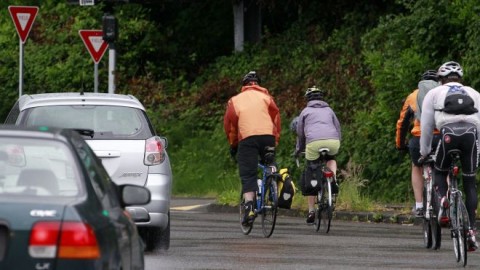SEATTLE – For many in Seattle, the image of a typical cyclist is a Spandex-clad, yellow-jacketed two-wheeled warrior who braves the steep streets of this city.
But as the city prepares to overhaul its five-year-old bike plan, some want to make the city safer and friendlier to those not so accustomed to navigating the streets on two wheels.
There's a new push to get "willing but wary" cyclists on their saddles with protected bike lanes buffered from traffic, designated bicycling boulevards where traffic is slowed and walkers and bikers have priority, and traffic calming features like speed bumps.
"We want to make sure we're building infrastructure for people who are eight or 80," and not just for the more experienced commuters, said Blake Trask, statewide policy director for the Washington Bicycle Alliance who formerly headed Seattle's bike advisory board.
The city is planning to build seven miles of walking and biking boulevards in five neighborhoods this year, with more likely on the way. So-called neighborhood greenways modeled after ones in Portland, Ore., are designed to make it safer for walkers and bikers to get between their home and school, the grocery store and park.
The city is taking public comment on the new plan, which would also consider features that separate cyclists from cars, called cycle tracks. They're common in bike-friendly European cities like Copenhagen and Amsterdam, but more U.S. cities such as Washington, D.C., and New York City are trying them out.
Still, any talk of bike improvements in Seattle is sure to stoke resentment from some, who believe the city's policies favor bike and transit over cars. Local talk-show hosts and columnists have ranted against what they call the city's anti-car campaign.
It hasn't helped that the city's most famous biker, Mayor Mike McGinn, sometimes known as "Mayor McSchwinn" for his enthusiasm about two-wheeled transportation, has irked some by increasing parking rates downtown and backing a measure to tax cars to pay for transit and bike improvements that even tax-friendly Seattleites rejected.
"We don't have a problem with the city investing in bike infrastructure," said Michael Ennis, transportation director for the conservative Washington Policy Center. "It's just when it's at the expense of auto lanes, then we start running into issues of fairness."
Seattle is losing unrestricted highway car lanes to transit and carpool lanes in various highway projects, including the Alaskan Way Viaduct and State Route 520, he noted. The city also put some streets on "road diets," shrinking car lanes to improve safety for cars and pedestrians.
"People see the visible painting of bike lanes and in some cases the narrowing of streets and perceive that as evidence that the city is spending more on bicycles than cars," said Seattle City Councilmember Tom Rasmussen, who heads the transportation committee.
Most of the city's transportation dollars go to streets, potholes and other street improvements, he said. Seattle spent about $9 million annually for the past four years on bicycling improvements, a small fraction of the city's total transportation budget of $300 million, Rasmussen said.
Council member and frequent bike commuter Mike O'Brien dismisses any talk of a "war on cars."
"No one is trying to force anyone to pick mode of transportation," said O'Brien. "It's not about taking away someone's car keys and demanding they get on a bike. But for people who do want to do it, they have a right to be safe getting back and forth to where they need to go."
As the city overhauls a plan currently aimed at tripling the number of cyclists in the city, many say they'd want features that cater to a broad range of riders.
The current plan "is working great for people who are already comfortable biking in the city," said Dylan Ahearn, who helped form Beacon BIKES after feeling the plan did a lot for commuters getting downtown but not as much for those getting around neighborhoods. "There's a wider segment of the population that could be served if they (the streets) were safer."
Ahearn says he understands the angst that motorists can feel toward cyclists. Neighborhood greenways with slower speed limits, signs, crosswalks and other features could help resolve some tension between them, he said.
Greenways "protect people by re-envisioning neighborhood streets as great public spaces, great community places," said Cathy Tuttle, coordinator of Seattle Neighborhood Greenways.
Tim King is working with other parents in Seattle to encourage more kids to bike to school. His 11-year-old daughter and 9-year-old son often bike by themselves about a half-mile to school.
He wants to see as many greenways as possible but he also favors dramatically lowering the speed limits in residential neighborhoods so people can pick the cycling route that's best for them.
"Seattle is a hard place to commute. I've spent a lot of time riding in Portland. It's easier to see how they have better ridership," he said, adding "it's tough to ride here. We've got our work cut out for us."

